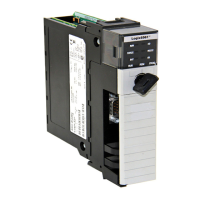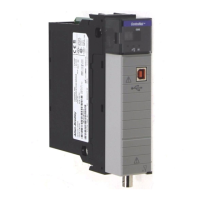Do you have a question about the Allen-Bradley 1756 ControlLogix and is the answer not in the manual?
Identifies changes applicable to all information about a subject in the manual.
Lists specific instruction changes with their reasons.
Describes the Studio 5000 Automation Engineering & Design Environment.
Lists documents with additional information concerning Rockwell Automation products.
Clears all motion faults for an axis; the only method for clearing axis motion faults.
Forces a specified axis into the Shutdown state.
Transitions a group of axes from the shutdown operating state to the axis ready operating state.
Deactivates the servo drive and sets the servo output voltage to the output offset voltage.
Activates the Drive Enable of the module, enabling the external servo drive, and sets the output voltage.
Activates the drive control loops for the specified axis and runs the motor at the specified speed.
Deactivates the drive output for the specified axis and deactivates the axis' servo loop.
Activates the drive amplifier for the specified axis and activates the axis' servo control loop.
Stops any motion process on an axis or stops the axis completely.
Homes an axis to an absolute specific position.
Moves an axis to a constant speed until told to stop.
Moves an axis to a specific position.
Starts electronic gearing between two axes.
Changes the speed, acceleration, or deceleration of a move or jog in progress.
Changes the command or actual position of an axis.
Calculates a cam profile based on an array of cam points.
Provides electronic camming between two axes according to the specified Cam Profile.
Provides electronic camming of an axis as a function of time, according to the specified Cam Profile.
Initiates a stop of motion on a group of axes.
Forces all axes in a group into the shutdown operating state.
Transitions a group of axes from the shutdown operating state to the axis ready operating state.
Arms motion module watch position event checking for a specified axis.
Disarms watch position event checking for an axis.
Arms registration event checking for the specified axis.
Disarms registration event checking for the specified axis.
Offers functionality to set and reset output bits based on an axis position.
Computes servo gains and dynamic limits based on a previously executed MRAT instruction.
Commands the motion module to run a tuning motion profile for the specified axis.
Applies results of MRHD to generate new encoder and servo polarities based on observed direction.
Commands the motion module to run one of three diagnostics on the specified axis.
Starts a single or multi-dimensional linear coordinated move for specified axes within a Cartesian coordinate system.
Initiates a two or three-dimensional circular coordinated move for specified axes within a Cartesian coordinate system.
Starts a multi-dimensional coordinated path move for specified axes within a Cartesian coordinate system.
Establishes a bidirectional transform between a Cartesian and a robot system.
Calculates the position of a point in one coordinate system to the equivalent point in a second.
Starts a change in path dynamics of the specified coordinate system.
Performs a controlled shutdown of all axes in the named coordinate system.
Initiates a controlled stop of coordinated motion.
Starts a transform that links two coordinate systems together.
Defines the CAM data type, consisting of slave and master point pairs, and interpolation type.
Defines the CAM_PROFILE data type as an array of coefficients representing a calculated cam profile.
Explains the syntax rules for writing structured text programs.
Explains how to use an assignment statement to change the value stored within a tag.
Describes how to write expressions using tags, equations, comparisons, functions, and operators.
Compares two values or strings to provide a true or false result.
Checks if multiple conditions are true or false, returning a BOOL value.
Manipulates bits within a value based on two values.
Explains the order in which operations in an expression are performed.
Describes constructs that can be programmed alone or nested within other constructs.
Explains how to use single byte or double byte encoded characters in string literals.
Defines the operands used in the IF_THEN statement.
Defines the operands used in the CASE_OF construct.
Defines the operands used in the FOR_DO loop.
Defines the operands used in the WHILE_DO loop.
Defines the operands used in the REPEAT_UNTIL loop.
Lists attributes common to Motion instructions and provides links for further information.
Explains how to use tags or expressions to dynamically change array elements.
Explains how to enter constant values (decimal, binary, octal, hexadecimal).
Explains how Logix controllers handle floating-point numbers according to the IEEE 754 standard.
Discusses limitations of LINT data types and where they can be used.
Lists and describes the elementary data types defined in IEC 1131-3.
Explains automatic data conversions that occur when mixing data types in programming.
Explains jerk as the rate of change of acceleration or deceleration.
Discusses choosing between Trapezoidal and S-curve profiles for velocity profiles.
Provides a procedure to balance smoothness and cycle time of an S-curve motion profile.
Lists error codes for Logix Designer software motion instructions.
Provides information to troubleshoot situations that could happen while running an axis.
| Brand | Allen-Bradley |
|---|---|
| Model | 1756 ControlLogix |
| Category | Controller |
| Language | English |











